Related Research Articles
Reverse Polish notation (RPN), also known as reverse Łukasiewicz notation, Polish postfix notation or simply postfix notation, is a mathematical notation in which operators follow their operands, in contrast to prefix or Polish notation (PN), in which operators precede their operands. The notation does not need any parentheses for as long as each operator has a fixed number of operands.
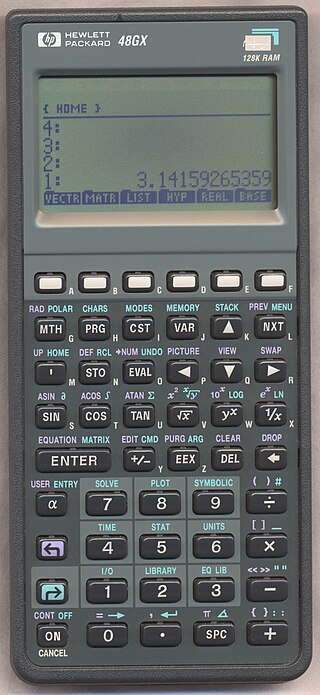
The HP 48 is a series of graphing calculators designed and produced by Hewlett-Packard from 1990 until 2003. The series includes the HP 48S, HP 48SX, HP 48G, HP 48GX, and HP 48G+, the G models being expanded and improved versions of the S models. The models with an X suffix are expandable via special RAM and ROM cards. In particular, the GX models have more onboard memory than the G models. The G+ models have more onboard memory only. The SX and S models have the same amount of onboard memory.
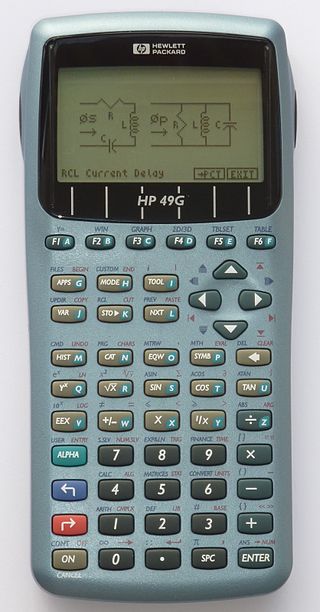
The HP 49/50 series are Hewlett-Packard (HP) manufactured graphing calculators. They are the successors of the popular HP 48 series.
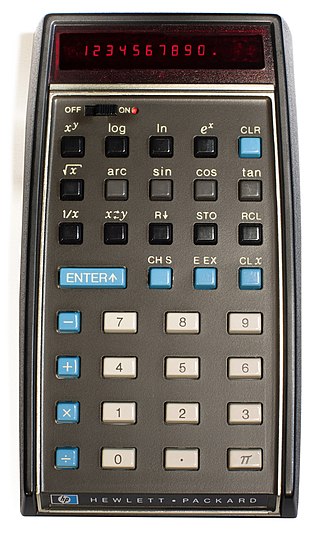
The HP-35 was Hewlett-Packard's first pocket calculator and the world's first scientific pocket calculator: a calculator with trigonometric and exponential functions. It was introduced in 1972.

The HP-65 is the first magnetic card-programmable handheld calculator. Introduced by Hewlett-Packard in 1974 at an MSRP of $795, it featured nine storage registers and room for 100 keystroke instructions. It also included a magnetic card reader/writer to save and load programs. Like all Hewlett-Packard calculators of the era and most since, the HP-65 used Reverse Polish Notation (RPN) and a four-level automatic operand stack.

The HP-42S RPN Scientific is a programmable RPN Scientific hand held calculator introduced by Hewlett-Packard in 1988. It has advanced functions suitable for applications in mathematics, linear algebra, statistical analysis, computer science and others.
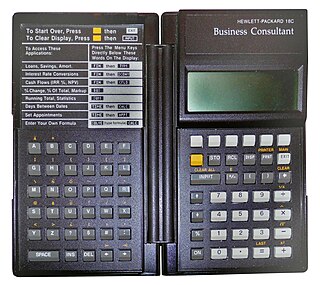
The HP-18C is a Hewlett-Packard business calculator which was quickly followed by the very similar but greatly improved HP-19B. The HP-18C is HP's first RPL-based calculator internally, even though this was not visible on user-level in this non user-programmable model. The user has a solver available, but only had about 1.5 KB of continuous memory available to store equations.
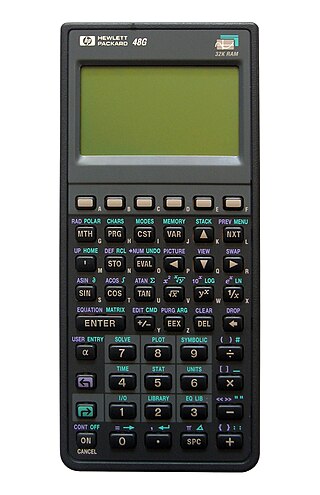
HP calculators are various calculators manufactured by the Hewlett-Packard company over the years.
There are various ways in which calculators interpret keystrokes. These can be categorized into two main types:

The Hewlett-Packard Voyager series of calculators were introduced by Hewlett-Packard in 1981. All members of this series are programmable, use Reverse Polish Notation, and feature continuous memory. Nearly identical in appearance, each model provided different capabilities and was aimed at different user markets.
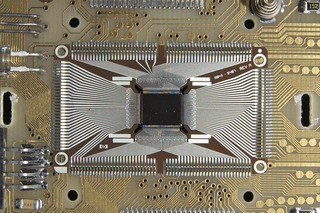
The Saturn family of 4-bit (datapath) microprocessors was developed by Hewlett-Packard in the 1980s first for the HP-71B handheld computer and then later for various HP calculators. It succeeded the Nut family of processors used in earlier calculators. The original Saturn chip was first used in the HP-71B hand-held BASIC-programmable computer, introduced in 1984. Later models of the family powered the popular HP 48 series of calculators. The HP48SX and HP48S were the last models to use genuine Saturn processors manufactured by HP. Later calculator models used Saturn processors manufactured by NEC. The HP 49 series initially used the Saturn CPU as well, until the NEC fab could no longer manufacture the processor for technical reasons in 2003. Therefore, starting with the HP 49g+ model in 2003, the calculators switched to a Samsung S3C2410 processor with an ARM920T core which ran an emulator of the Saturn hardware in software. In 2000, the HP 39G and HP 40G were the last calculators introduced based on the actual NEC fabricated Saturn hardware. The last calculators based on the Saturn emulator were the HP 39gs, HP 40gs and HP 50g in 2006, as well as the 2007 revision of the hp 48gII. The HP 50g, the last calculator utilizing this emulator, was discontinued in 2015 when Samsung stopped producing the ARM processor on which it was based.

The HP-28C and HP-28S were two graphing calculators produced by Hewlett-Packard from 1986 to 1992. The HP-28C was the first handheld calculator capable of solving equations symbolically. They were replaced by the HP 48 series of calculators, which grew from the menu-driven RPL programming language interface first introduced in these HP-28 series.
HP 39/40 series are graphing calculators from Hewlett-Packard, the successors of HP 38G. The series consists of six calculators, which all have algebraic entry modes, and can perform numeric analysis together with varying degrees of symbolic calculation. All calculators in this series are aimed at high school level students and are characterized by their ability to download APLETs or E-lessons. These are programs of varying complexity which are generally intended to be used in the classroom to enhance the learning of mathematics by the graphical and/or numerical exploration of concepts.

The HP 35s (F2215A) is a Hewlett-Packard non-graphing programmable scientific calculator. Although it is a successor to the HP 33s, it was introduced to commemorate the 35th anniversary of the HP-35, Hewlett-Packard's first pocket calculator. HP also released a limited production anniversary edition with shiny black overlay and engraving "Celebrating 35 years".
A graphing calculator is a class of hand-held calculator that is capable of plotting graphs and solving complex functions. While there are several companies that manufacture models of graphing calculators, Hewlett-Packard is a major manufacturer.

The HP-55 was a programmable handheld calculator, a lower-cost alternative to the HP-65. Introduced by Hewlett-Packard in 1975, it featured twenty storage registers and room for 49 keystroke instructions. Its outward appearance was similar to the HP-65, but its silver band went through between the display and the keyboard like HP-45, and the functions of some keys were different from HP-65, and it did not have a magnetic card reader/writer. Like all Hewlett-Packard calculators of the era and most since, the HP-55 used Reverse Polish Notation (RPN) and a four-level automatic operand stack.

The HP Prime Graphing Calculator is a graphing calculator introduced by Hewlett-Packard in 2013 and manufactured by HP Inc. until the licensees Moravia Consulting spol. s r.o. and Royal Consumer Information Products, Inc. took over the continued development, manufacturing, distribution, marketing and support in 2022. It was designed with features resembling those of smartphones, such as a full-color touchscreen display and a user interface centered around different applications. It claims to be the world's smallest and thinnest CAS-enabled calculator currently available.
Christophe de Dinechin is a French computer scientist, with contributions in video games, programming languages and operating systems.
The RPL character set is an 8-bit character set and encoding used by most RPL calculators manufactured by Hewlett-Packard as well as by the HP 82240B thermo printer. It is sometimes referred to simply as "ECMA-94" in documentation, although it is for the most part a superset of ISO/IEC 8859-1 / ECMA-94 in terms of printable characters, and it differs from ISO/IEC 8859-1 by using displayable characters rather than control characters in the 0x80 to 0x9F range of code points.
In computing FOCAL character set refers to a group of 8-bit single byte character sets introduced by Hewlett-Packard since 1979. It was used in several RPN calculators supporting the FOCAL programming language, like the HP-41C/CV/CX as well as the later HP-42S, which was introduced in 1988 and produced up to 1995. As such, it is also used by SwissMicros' DM41/L, both introduced in 2015, and is implicitly supported by the DM42, introduced in 2017.
References
- ↑ "The Joy of Programming?". Museum of HP Calculators. 2020. Archived from the original on 2021-12-03.
- 1 2 Patton, Charles M. (August 1987). "Computation for Handheld Calculators" (PDF). Hewlett-Packard Journal . 38 (8). Palo Alto, California, USA: Hewlett-Packard Company: 21–25. Archived from the original (PDF) on 2011-12-06. Retrieved 2015-09-12.
- 1 2 3 Hewlett-Packard. "RPLMan from Goodies Disk 4" (RPLMAN.ZIP). Retrieved 2015-09-12.
- ↑ Horn, Joseph K. "What is RPL?". Archived from the original on 2017-09-17. Retrieved 2017-09-17.
- ↑ Wessman, Timothy "Tim" James (2016-06-21) [2016-06-20]. "What to do with stack overflow OBJ->/LIST->?". MoHPC - The Museum of HP Calculators. Archived from the original on 2023-09-24. Retrieved 2023-09-24.
- ↑ Wickes, William C. (January–February 1987). "The HP-28C: An Insider's Perspective". HPX Exchange. 1 (1).
- ↑ Kuperus, Klaas (2015-03-04). "HP 50g: End of an era". Moravia. Archived from the original on 2015-04-02.
- ↑ Kuperus, Klaas (2015-03-06). "HP 50g not so good news?". Moravia. Retrieved 2016-01-01.
- ↑ Wessman, Timothy "Tim" James (2015-12-26). "Windows 10 won't allow HP 50g USB drivers to be installed". MoHPC - The Museum of HP Calculators. Retrieved 2016-01-01.
- ↑ Lapilli, Claudio Daniel (2014-01-03). "newRPL" . Retrieved 2015-09-12. (an open source RPL derivative for the HP 50g and HP 49g+, the HP 40gs, HP 39gs and hp 39g+ as well as the HP Prime)
- ↑ Lapilli, Claudio Daniel (2021-07-23) [2014]. "newRPL Documentation Project". newRPL. Archived from the original on 2023-11-03. Retrieved 2023-10-23.
- ↑ de Dinechin, Christophe (2022). "DB48X on DM42 - RPL runtime for the DM42 calculator, in the spirit of HP48/49/50". DB48X. Archived from the original on 2023-11-03. Retrieved 2023-10-23.
- ↑ de Dinechin, Christophe (2023-02-03). "Reviving Reverse Polish Lisp - Building an open-source HP48-like calculator". FOSDEM . Archived from the original on 2023-10-03. Retrieved 2023-10-03. (NB. An improved derivative of RPL called DB48X for the SwissMicros DM42 and DM32.)
- ↑ Lapilli, Claudio Daniel (2014-10-31). "N-Queens on 50g (RPL language)". MoHPC - The Museum of HP Calculators. Archived from the original on 2023-11-03. Retrieved 2023-10-23.
- ↑ Wickes, William C. (1988-10-01) [14–18 June 1988]. Forsely, Lawrence P. (ed.). RPL: A Mathematical Control Language. Proceedings of the 1988 Rochester Forth Conference: Programming Environments. Vol. 8. Rochester, New York, USA: Institute for Applied Forth Research, Inc., University of Rochester. pp. 27–32. ISBN 978-0-91459308-9. OCLC 839704944.
Several existing operating systems and languages were considered, but none could meet all of the design objectives. A new system was therefore developed, which merges the threaded interpretation of Forth with the functional approach of Lisp. The resulting operating system, known unofficially as RPL (for Reverse-Polish Lisp), made its first public appearance in June of 1986 in the HP-18C Business Consultant calculator.
(NB. This title is often cited as "RPL: A Mathematics Control Language". An excerpt is available at: ) - ↑ Wickes, William C. (1991-03-11). "RPL stands for Reverse Polish Lisp". www.hpcalc.org. Retrieved 2015-09-12.
RPL stands for Reverse Polish Lisp. In the early days of RPL development, we got tired of calling the unnamed system "the new system", and one of the development team came up with "RPL", both as a play on "RPN" which has been the loved/hated hallmark of HP calcs forever, and as an accurate indication of the derivation of the language from Forth and Lisp.
RPL was never particularly intended to be a public term; at the time of the HP Journal article (August 1987) on the HP 28C there was an attempt to create a less whimsical name--hence "ROM-based procedural language", which preserved the initials but had a more dignified sound. The development team never calls it anything but (the initials) RPL. You can choose either of the two full-word versions that you prefer. Or how about "Rich People's Language?" Bill Wickes, HP Corvallis. - ↑ Schoorl, André (2000-04-04) [1997]. "HP48 Frequently Asked Questions List". HP Calculator Archive. p. 69. Retrieved 2015-09-12.
- ↑ "I've heard the names RPL, Saturn, STAR, GL etc... What are they? - RPL". FAQ: 2 of 4 - Hardware, Programs, and Programming. 4.62. comp.sys.hp48. 2000-04-14. 8.1. Retrieved 2015-09-12.
- ↑ Nelson, Richard J. (2012-04-04). "HP RPN Evolves" (PDF). HP Solve (27). Hewlett-Packard: 30–32. Retrieved 2015-09-12.
- 1 2 Mier-Jędrzejowicz, Włodzimierz "Włodek" Anthony Christopher (July 1991). A Guide to HP Handheld Calculators and Computers (5 ed.). HHC 2011. ISBN 978-1-88884030-8. 1888840307.
RPL stands for Reverse Polish Lisp - it combined the RPN calculator language of earlier models with features of the Lisp and Forth programming languages. For a time HP explained the letters RPL as an acronym for "ROM-based Procedural Language".
- ↑ "HP Celebrates 35 Years of Handheld Calculator Innovation". Hewlett-Packard Development Company, L.P. 2007. Archived from the original on 2007-03-17. Retrieved 2015-09-13.
1987: HP-28C: First full RPL calculator: In the late 1980s, HP developed a new programming language for its new series of extremely powerful calculators. By combining elements of RPN, Lisp and Forth, HP came up with a language called RPL (or ROM-based Procedural Language).
- ↑ Rechlin, Eric; Marangon, Carlos. "HPedia: The HP Calculator Encyclopedia". www.hpcalc.org. Retrieved 2020-04-20.
- http://h41268.www4.hp.com/live/index_e.aspx?qid=20709&jumpid=va_r11363_us/en/any/tsg/pl_ot_ob_ds_pd/calculatoremulators_cc/dt%5B%5D
- http://www.calculatrices-hp.com/index.php?page=emulateurs
- "Emulator of HP 50g with #2.16 ROM".
- http://www.calculatrices-hp.com/uploads/emulateurs/HP50gVirtualCalculatorSetup_3_1_30.zip